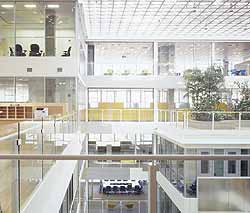Green Products: Trends & Innovations
Controlling Natural Light
A "green" building on the other coast, the Genzyme Center in Cambridge, Mass., was designed by Behnisch, Behnisch & Architects, Stuttgart, Germany, to be one of the most environmentally responsible office buildings ever built in the United States.
At Genzyme, all the interior lighting participants−those involved with active solar controls, interior lighting and lighting control−met very early in the project and continued to meet as a team, says Tom Myers, senior sales manager for corporate accounts for Coopersburg, Pa.-based Lutron Electronics, Inc., a manufacturer of lighting and shading controls and systems.
|
From the time its 350,000 square foot, 12-story, Cambridge, Mass. headquarters building was conceived, Genzyme was in pursuit of a Platinum LEED rating. The building is still under review by the USGBC.
Genzyme went to extraordinary lengths to maximize the benefits of natural daylighting.
A rooftop heliostat (which tracks the sun as it moves across the sky) is anchored above a 12-story atrium, and, combined with a network of mirrors, drives sunlight down through the atrium. Reflective motorized blinds and reflective ceiling panels drive natural light from perimeter windows to the floorplate.
Filigree concrete slab-construction provided cantilevered floors and wide spans, allowing for an extensive glass exterior, a third of which is a double-façade. More than 800 operable windows and a highly efficient glass envelope are expected to contribute to an overall 40 percent savings in energy costs.










